Ince Minaret Medrese
İnce Minareli Medrese (literally Slender Minaret Medrese) is a 13th-century madrasa (Islamic school) located in Konya, Turkey, now housing the Museum of Stone and Wood Art (Taş ve Ahşap Eserler Müzesi). Some of its notable features are the calligraphic portal that serves as the entrance to the complex, its covered dome at the center of the courtyard, and the highly ornate minaret attached to the complex, partially destroyed in 1901. The Medrese is significant because it encapsulates many themes that emerge in Seljuk Anatolia and its corresponding architecture, such as a centrally-planned dome and elaborate ornamental brickwork.
| İnce Minareli Medrese | |
|---|---|
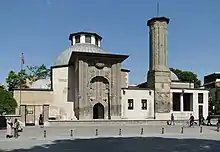 İnce Minareli Medrese, front facade. | |
| Religion | |
| Affiliation | Islam |
| District | Konya |
| Province | Konya |
| Region | Central Anatolia |
| Location | |
| Location | Konya, Turkey |
 Location in Turkey | |
| Geographic coordinates | 37.5222°N 32.2924°E |
| Architecture | |
| Type | Madrasa |
| Style | Islamic, Seljuk architecture |
| Completed | 1279 |
| Minaret(s) | 1 |
History
The Seljuks, the first Turkish dynasty to rule the Islamic world, converted to Islam in the 10th century. As the Seljuks were Sunni, they wanted to encourage Sunnism through the establishment of mass public education in locations such as madrasas, or legal colleges. The Seljuks in Anatolia simultaneously supported a return to the ideas of Sufism or Islamic mysticism. This is due in part to the influx of Sufis into the region in the early 13th century, largely from central Asia as they attempted to outrun the Mongol conquests. The Sufi presence became so prominent in Anatolia, in fact, that some scholars believe institutions like madrasas began to have features like Sufi gathering spaces added onto them in order to facilitate conversation and debate between Sufis and “ulema.”[1]
It is also worth noting that Konya was a metropolitan center which became a “sultanate city” under Seljuk rule, making it an especially well-funded city.[2] Konya as a capital saw extensive expansion efforts under the rule of ‘Alā’ al-Dīn Kayqubād, who ruled from 1220-1237.[3]
After the decline in Seljuk sultanate patronage around the year 1243, however, Ṣāḥib ‘Aṭā Fakhr al-Dīn ‘Alī was one of two major patrons of architecture in Konya in the following decades, after the capital had been taken back from the Mongols. He was the vizier who commissioned the Ince Minaret Medrese in 1265. In order to expand Konya as a capital of learning and political power, Ṣāḥib ‘Aṭā Fakhr al-Dīn ‘Alī commissioned sites outside of the city’s center to expand new sections.[4] Upon his death in 1285, he was still a fairly powerful figure in Konya and is buried in his “mosque complex” within the city.[5]
Architecture
Complex Layout
The Ince Minaret Medrese is built close to the old center of Seljuk rule, at the foot of the citadel hill in Konya.[6] The complex of the Medrese is approximately 23.60 meters by 20.30 meters, or about 77.4 feet by 66.6 feet.[7] In the center of the rectangular complex is a dome-covered courtyard which is surrounded by the rooms of the Medrese, or Islamic religious school, on the north, south and west sides. The student rooms are located on the north and south sides of the centrally-placed dome and the medrese classrooms are located on the west side.[8] On the east side of the courtyard is a single-domed mosque with the minaret with two balconies, or şerefes in Turkish, on the south-eastern corner.[9] The courtyard includes a single iwan facing the entrance, or a courtyard space with barrel-vaulted halls and rectangular and square side chambers, which emulates an ancient Persian rectangular space layout that became a standard type during the era of Seljuk Anatolia.[10]
Typical of medieval Islamic architecture, the integration of the mosque into the Medrese architectural plan is evidence of the complex’s multitude of purposes as a religious place of worship and of teaching.[11] The exterior of the complex is made of cut stone, the outer side walls are made of rubble and stone, and the interior uses brick for structural and ornamental purposes.[12] The use of brick decoration was a common feature of Seljuk buildings due to its connections to traditional Anatolian brick architecture.[13]
Portal and Facade
The portal of the building is surrounded by highly ornamented stonework which stretches up the entire facade. While other contemporary Seljuk constructions made use of muqarnas hoods above the entry, the Ince Minaret Medrese instead includes large stone banners of text.[14] Sura 36 and Sura 110 are inscribed in prominent vertical bands of thuluthcalligraphy that intertwine and separate just above the doorway.[15][16] Geometric and vegetal designs likewise adorn the facade, taking the form of knots, branches, and leaves. Apart from displaying the stonework and script, the facade also conceals the layout of the interior spaces behind it.[10] Within two rosettes framing the portal are inscriptions attesting to the building’s architect, Kölük bin Abdullah, who also designed the Gök Medrese in Sivas as well as the nearby Sahip Ata Complex in Konya. Abdullah is hypothesized to have worked on a number of Ṣāḥib ‘Aṭā Fakhr al-Dīn’s commissions.[17]
Dome
At the center of the courtyard is the centrally-planned, covered dome. Although central plans were common in late Seljuk architecture, the Ince Minaret Medrese diverged from previous centrally-planned courtyards with the addition of the covered dome space. The large central dome emulates pre-Seljuk Anatolian architecture, specifically earlier mosque plans and the standard Anatolian Byzantine church style.[18]
The dome itself receives light by means of a lantern, which illuminates the covered courtyard space.[19] It is supported by four triangular fan pendentives made of exposed brick work.[20] The side chambers of the dome are not decorated at all, which increases the striking aesthetic properties of the central space.[21] The interior of the dome is covered in alternating turquoise and black tiles in geometric patterns that bear an inscription in kufic script.[21]
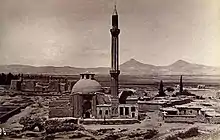
Minaret
The Ince Minaret Medrese’s name refers to the structure’s original extremely tall minaret, which once possessed two balconies. In 1901, however, the minaret was partially destroyed by a lightning strike.[22] The lightning strike caused the minaret to fall on the complex’s mosque, which destroyed its dome and resulted in subsequent repairs using concrete and glass.[23] The minaret is located near the gateway of the dome. The base of the minaret is square shaped and built out of brick.[24] As the base goes upward, the square shape gives way to a cylindrical form. Glazed bricks are strategically placed a slight distance apart in a cylindrical geometric pattern, generating an illusion of free-hanging materials.[22] In addition, green tiles as well as geometric motifs decorate the outer portion of the minaret, creating a distinct Seljuk style of architecture and artwork.[22] It was common practice for Seljuk buildings to be lined in glazed brick and ornamented with a decorative style.[22]
Gallery
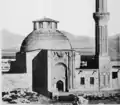 Old historical photo
Old historical photo Ince Minare Medrese Museum exterior 2920
Ince Minare Medrese Museum exterior 2920 Ince Minare Medrese Museum exterior 060
Ince Minare Medrese Museum exterior 060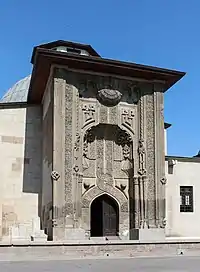 Detail of the facade
Detail of the facade The highly ornamented stone façade of the entrance of the İnce Minareli Medrese.
The highly ornamented stone façade of the entrance of the İnce Minareli Medrese. Model of the İnce Minareli Medrese, showing the original height of its minaret.
Model of the İnce Minareli Medrese, showing the original height of its minaret. Ince Minare Medrese Museum central room 4032
Ince Minare Medrese Museum central room 4032 Ince Minare Medrese Museum double headed eagle 2853
Ince Minare Medrese Museum double headed eagle 2853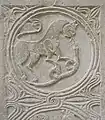 Ince Minare Medrese Museum imaginary animal relief 4081
Ince Minare Medrese Museum imaginary animal relief 4081 Ince Minare Medrese Museum Seljuk architectural fragment 4037
Ince Minare Medrese Museum Seljuk architectural fragment 4037 Ince Minare Medrese Museum Seljuk architectural fragment 4092
Ince Minare Medrese Museum Seljuk architectural fragment 4092 Ince Minare Medrese Museum Seljuk winged angel 4061
Ince Minare Medrese Museum Seljuk winged angel 4061 Ince Minare Medrese Museum Beykim Mescit detail 2903
Ince Minare Medrese Museum Beykim Mescit detail 2903 Ince Minare Medrese Museum Hasbey Dar'ül Huffazı door 4051b
Ince Minare Medrese Museum Hasbey Dar'ül Huffazı door 4051b Ince Minare Museum mihrab of Ulri Sultan Mescit 3572
Ince Minare Museum mihrab of Ulri Sultan Mescit 3572
References
- Blessing, Patricia. Rebuilding Anatolia after the Mongol Conquest : Islamic Architecture in the Lands of Rūm, 1240-1330 / Patricia Blessing, Stanford University, USA. Routledge, 2016. pp.29.
- Özcan, Koray (2010). "The Anatolian Seljuk City An Analysis on Early Turkish Urban Models in Anatolia". Central Asiatic Journal. 54 (2): 273–290. ISSN 0008-9192.
- Blessing, Patricia. Rebuilding Anatolia after the Mongol Conquest : Islamic Architecture in the Lands of Rūm, 1240-1330 / Patricia Blessing, Stanford University, USA. Routledge, 2016. pp. 25.
- Blessing, Patricia. Rebuilding Anatolia after the Mongol Conquest : Islamic Architecture in the Lands of Rūm, 1240-1330 / Patricia Blessing, Stanford University, USA. Routledge, 2016, pp. 22.
- Blessing, Patricia. Rebuilding Anatolia after the Mongol Conquest : Islamic Architecture in the Lands of Rūm, 1240-1330 / Patricia Blessing, Stanford University, USA. Routledge, 2016. pp. 24
- Blessing, Patricia. Rebuilding Anatolia after the Mongol Conquest : Islamic Architecture in the Lands of Rūm, 1240-1330 / Patricia Blessing, Stanford University, USA. Routledge, 2016, pp. 61.
- Yekta Demiralp "Ince Minareli (‘Slender Minaret’) Madrasa" in Discover Islamic Art, Museum With No Frontiers, 2020. http://islamicart.museumwnf.org/database_item.php?id=monument;ISL;tr;Mon01;8;en
- Yekta Demiralp "Ince Minareli (‘Slender Minaret’) Madrasa" in Discover Islamic Art, Museum With No Frontiers, 2020. http://islamicart.museumwnf.org/database_item.php?id=monument;ISL;tr;Mon01;8;en
- Yekta Demiralp "Ince Minareli (‘Slender Minaret’) Madrasa" in Discover Islamic Art, Museum With No Frontiers, 2020. http://islamicart.museumwnf.org/database_item.php?id=monument;ISL;tr;Mon01;8;en
- Blessing, Patricia. Rebuilding Anatolia after the Mongol Conquest : Islamic Architecture in the Lands of Rūm, 1240-1330 / Patricia Blessing, Stanford University, USA. Routledge, 2016, pp. 51.
- Hillenbrand, R. (1994), ‘Islamic architecture: form, function and meaning’, Edinburgh University Press, Edinburgh, p. 211
- TAŞ VE AHŞAP ESERLERİ MÜZESİ (İNCE MİNARE).” Muze , Government of Turkey, muze.gov.tr/muze-detay?SectionId=KIM01&DistId=MRK.
- “Ince Minare Madrasa.” Muslim Heritage, 3 Dec. 2019, muslimheritage.com/ince-minare-madrasa/.
- Blessing, Patricia. Rebuilding Anatolia after the Mongol Conquest : Islamic Architecture in the Lands of Rūm, 1240-1330 / Patricia Blessing, Stanford University, USA. Routledge, 2016, pp. 50.
- Schimmel, Annemarie. Islamic Calligraphy, (Brill, 1970), 22.
- “Ince Minare Madrasa.” Muslim Heritage, 3 Dec. 2019, muslimheritage.com/ince-minare-madrasa/.
- "Gizlilik Bildirimi - Fikriyat Gazetesi". www.fikriyat.com. Retrieved 2020-11-11.
- Hillenbrand, Robert (1994). Islamic architecture: form, function and meaning. Edinburgh: Edinburgh University Press. p. 211.
- "Ince Minare Madrasa". Muslim Heritage. 2005-03-11. Retrieved 2020-12-09.
- Michell, M. (1978). Architecture of the Islamic World. London: Thames and Hudson. p. 244.
- Blessing, Patricia (2016). Rebuilding Anatolia after the Mongol Conquest : Islamic Architecture in the Lands of Rūm, 1240-1330. Stanford University: Routledge. p. 50.
- "Ince Minare Madrasa". Muslim Heritage. 2005-03-11. Retrieved 2020-12-09.
- Blessing, Patricia (2016). Rebuilding Anatolia after the Mongol Conquest : Islamic Architecture in the Lands of Rūm, 1240-1330. Stanford University: Routledge. p. 50.
- "Ince Minareli Medrese | Archnet". archnet.org. Retrieved 2020-12-09.
Bibliography
- Blessing, Patricia. Rebuilding Anatolia after the Mongol Conquest : Islamic Architecture in the Lands of Rūm, 1240-1330 / Patricia Blessing, Stanford University, USA. Routledge, 2016, p.21-67.
- Blessing, Patricia, and Rachel Goshgarian. Architecture and Landscape in Medieval Anatolia, 1100--1500 / Edited By Patricia Blessing And Rachel Goshgarian. Edinburgh University Press, 2018.
- Demiralp, Yekta. "Ince Minareli (‘Slender Minaret’) Madrasa" in Discover Islamic Art, Museum With No Frontiers, 2020. http://islamicart.museumwnf.org/database_item.php?id=monument;ISL;tr;Mon01;8;en
- "Gizlilik Bildirimi - Fikriyat Gazetesi". www.fikriyat.com.
- Hillenbrand, R. (1994), ‘Islamic architecture: form, function and meaning’, Edinburgh University Press, Edinburgh.
- “Ince Minareli Medrese.” Archnet, archnet.org/sites/2048.
- “Ince Minareli Madrasa.” dome.mit.edu/handle/1721.3/65508.
- “Ince Minare Madrasa.” Muslim Heritage, 3 Dec. 2019, muslimheritage.com/ince-minare-madrasa/.
- Michell, M. et al. (eds.) (1978), ‘Architecture of the Islamic World’, Thames and Hudson, London.
- Özcan, Koray. "The Anatolian Seljuk City An Analysis on Early Turkish Urban Models in Anatolia." Central Asiatic Journal 54, no. 2 (2010): 273-90. Accessed October 28, 2020. http://www.jstor.org/stable/4192856.
- Schimmel, Annemarie. Islamic Calligraphy, (Brill, 1970).
- “TAŞ VE AHŞAP ESERLERİ MÜZESİ (İNCE MİNARE).” Muze, Government of Turkey, muze.gov.tr/muze-detay?SectionId=KIM01&DistId=MRK.
External links
| Wikimedia Commons has media related to Ince Minare Museum. |
- "İnce Minareli Medrese in Konya". ArchNet. Archived from the original on 2006-02-18. Retrieved 2017-03-15.
- Many pictures from the Ince Minaret museum